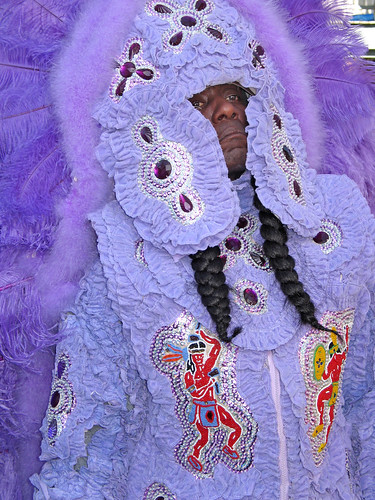“Treme” Explained
“Hey, you seen ‘Treme?'”
When I was back home in New Orleans, HBO’s new locally-based series was the talk of the town. With practically everyone I talked to, the feelings are overwhelmingly positive. Although there are some “Treme”-haters (and one is certainly welcome to dislike the show for one’s own reasons), they seem to be in the minority, as New Orleanians for the most part embrace the show and have been organizing “Treme” watching parties, in private homes and organized in public places, like the Charbonnet-Labat Funeral Home on St. Philip Street in the show’s namesake neighborhood.
Given that I’ve been out of town I’ve been remiss in writing about the show myself, but here are my feelings in a nutshell. I love it.
Some people quibble about little inaccuracies in the geography or culture, mostly anachronisms (“That wasn’t open for two more months after this is set!”), but all that can be easily brushed away. The producers and writers are going well out of their way to be true to the culture and spirit of the city, and the story they’re putting together serves a greater truth. We also must remember that this isn’t a documentary, it’s fiction — they’re telling a story, and fictional and fictionalized elements of reality enter into it. It all boils down to the story they’re telling rings true to so many New Orleanians, reflective of their feelings and experiences after the storm and the Federal flood.
The characters, many of them based on real people, ring true as well. We’ve known people like this. The most astonishing character of all is Clarke Peters’ Big Chief Albert Lambreaux — not only the standout character on the show, but one of the standout characters in any show I’ve ever seen. His dignity, determination, pride and complexity are a rare thing in episodic television, and to think … he’s portraying the black Mardi Gras Indian community and doing it well! The respect and honor shown to the Indian culture by this show blows me away, and as far as I know it’s the first and only portrayal of that rich subculture of New Orleans outside of a documentary.
Here are a couple of my own photos of Indians parading in the Tremé on Mardi Gras Day 2006, the first one post-Katrina.

Because I’m behind, this is going to be sorta five posts in one — let’s get going.
Dave Walker, longtime television writer for the New Orleans Times-Picayune, is one of many New Orleanians who’ve been writing about the show. Da Papuh has an entire sub-site about “Treme,” and one feature Dave’s been writing each week is called “‘Treme’ Explained,” which is a guide to all the unexplained references to New Orleans in each episode. These are li’l tidibits that most New Orleanians are probably going to catch, but lots of people from elsewhere probably won’t. It helps make the show that much richer on your second, third and subsequent viewings.
Here are links to the columns so far, with a few excerpts and other tidbits. There are a few spoilers, so if you haven’t seen the first five episodes yet, you might want to refrain from reading further until you have.
Episode 1: “Do You Know What It Means?”
My first reaction after seeing the pilot episode: “I could not have dreamed that it would be this good.” Quibbles notwithstanding.
For starters, view a comprehensive archive of the Times-Picayune’s Katrina coverage, including an animated map of the levee failures.
It’s pronounced treh-MAY. Or TREH-may. Or … oh, just watch the video.
A second line is a neighborhood street parade. Typically, participants include a sponsoring social aid and pleasure club and brass band (the main line) and whoever else wants to participate (the second line). Second line photos and videos.
Social aid and pleasure clubs date to the late 19th century. One of their early functions was to provide funeral insurance for members. David Kunian – WWOZ-FM show host and ace New Orleans music documentarian – has the written the definitive piece.
The second line that opens the premiere of “Treme” is meant to re-create a second line staged on Oct. 9, 2005 in honor of Austin Leslie (a photo of Leslie can be glimpsed, very briefly, on an attendee’s fan).
TV-history bonus: Austin Leslie was a master of Creole soul food who served as one of the inspirations for the great CBS TV comedy “Frank’s Place,” He died in Atlanta at age 71 a few weeks after Hurricane Katrina.
The bridge causing Davina Lambreaux so much anxiety is the Crescent City Connection, which spans the Mississippi River and links the east and west banks of New Orleans. After Hurricane Katrina, people attempting to evacuate the flooded east bank across the bridge to the dry west bank were turned back by law enforcement. Stories here and here.
The opening theme is “Treme Song,” by John Boutte. It’s playing on a loop in my head and also here.
The WWOZ-FM 90.7 live stream is here.
The song that plays under the closing credits is “My Darlin’ New Orleans” by Little Queenie. Hear it on her MySpace page here.
I’m generally not one to toot my own horn, but “My Darlin’ New Orleans” is back in print and available for the closing credits because I put it on the “Doctors, Professors, Kings and Queens: The Big Ol’ Box of New Orleans” box set six years ago. I’m proud to have made my li’l contribution there.
😉






